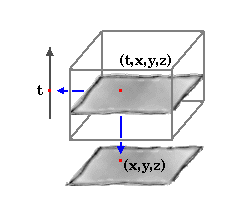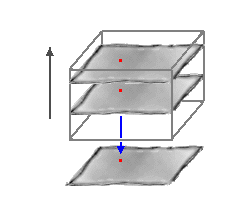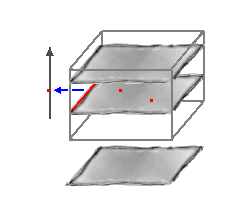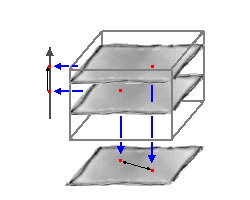
| Home |

|
PREFACE | PRIMEVAL | SPECIAL | GENERAL | CONCLUSION |
| | | ||||||
| Dictionary | Events | Aristotle | Galileo | Newton |
 |
|---|
| Aristotle (384-322 B.C.) |
Aristotle was interested in motion. He realized that motion can be understood by seeing how the location of an object changed. And that one could talk about "one object moving faster than another" by comparing how much the location of each changed in some interval of time.
- Every sensible body is by its nature somewhere. (Physics,Book 3, 205a:10)
- Time is the numeration of continuous movement. (Physics, Book 4, 223b:1)
It is not our purpose to critically discuss Aristotle and his views concerning space and time. We are exercising our poetic license to use him to represent the ancient pre-Renaissant views of space and time.
Let us a try to draw a picture of Aristotle's view of space, time, and motion.
Recall: We are trying to understand the physical relationship between events. We do so by modeling the set of events with a mathematical model: spacetime. A good model should accurately display certain features that reflect these relationships. For spacetime-models, these features are certain geometric figures that are somehow automatically built into the model.
Imagine a 4-dimensional cube, sliced into a stack of horizontal 3-planes.
(If this bothers you, revisit
the discussion on 4-dimensionality in
Introducing Spacetime.
Don't forget to come back using  !)
!)
 |
|---|
|
ARISTOTLE'S SPACETIME
Each horizontal plane represents "an instant of time". Each point on that plane represents "a position in space (at that instant of time)". |
Here are some key features of this model:
Aristotelian Map Reading 101:
How to recover "space" and "time" from "spacetime"

Two events at the same place: "coincident in space"(...since these two events lie on the same vertical line.)

Two events at the same time: "coincident in time" or "simultaneous".(...since these two events lie on the same horizontal plane.)

The "time elapsed" (temporal separation) between two events.(Find the shadows of these events onto the vertical line, then measure this time-difference by measuring the length along the vertical line.)The "spatial distance" (spatial separation) between two events.(Find the shadows of these events onto a common horizontal plane, then measure this distance on this horizontal plane.)
This then will be our first spacetime model, that is, our first mathematical model of the physical notion of "the history of the universe".
And, the Aristotelians have provided us a method by which we can recover "space" and recover "time" from "spacetime".
According to Aristotle, there is a privileged being: The Prime Mover. He is the first agent, responsible for moving objects, which, in turn, move other objects.
The Prime Mover, he argued, must be at Absolute Rest. By "absolute" rest , we mean that all observers will universally agree on that state of rest.
In this spacetime, The Prime Mover has a vertical worldline since he is always at rest. That is to say, he is always in the same position at each instant in time.
 A poetic interpretation of Aristotle's Spacetime
A poetic interpretation of Aristotle's SpacetimeThe Prime Mover carries a big clock on his chest. He has a gridwork (or "jungle-jim") of metersticks laid out everywhere in space. With a loud voice, which can be heard everywhere instanteously, he declares "Take a branding-iron and sear each point in space with three numbers (x,y,z) that locate how far in the x, y, and z directions that point is from Me, who sits at x=0, y=0, z=0."
This is Aristotle's Spacetime. To recover space, look at the label branded on that point in space. To recover time, listen to the Prime Mover's clock announcements.
ARISTOTLE'S LAW OF MOTION
If, then, A is the moving agent, B the mobile, C the distance
traversed and D the time taken, then A will move B/2 over the distance 2C
in time D, and A will move B/2 over the distance C in time D/2;
for so the proportion will be observed. (Physics VII 249b-250a)
Force is proportional to the velocity. F=mv.
ARISTOTLE'S LAW OF GRAVITATION
Heavy objects fall faster than light objects.
| Home |

|
PREFACE | PRIMEVAL | SPECIAL | GENERAL | CONCLUSION |
| Dictionary | Events | Aristotle | Galileo | Newton |